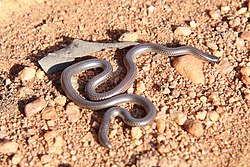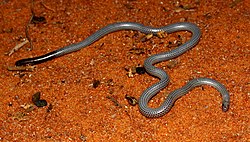| Common name | Scientific name [2] | Taxon author [2] | Habitat & Range |
|---|
| Ethiopian worm snake | Leptotyphlops aethiopicus [3] | Broadley & Wallach, 2007 | Habitat: Forest, grassland Range: Ethiopia, Kenya [4] |
|---|
| Cape thread snake  | Leptotyphlops conjunctus | (Jan, 1861) | Habitat: Grassland Range: South Africa (Eastern Cape Province) [5] |
|---|
| Distant's thread snake  | Leptotyphlops distanti | (Boulenger, 1892) | Habitat: Savanna, grassland Range: Mozambique, South Africa (Limpopo Province, North-West Province, Mpumalanga, Gauteng) [6] |
|---|
| Emin Pasha's worm snake | Leptotyphlops emini | (Boulenger, 1890) | Habitat: Savanna, shrubland Range: The Democratic Republic of the Congo, Kenya, South Sudan, United Republic of Tanzania, Uganda, Zambia [7] |
|---|
| Howell's worm snake | Leptotyphlops howelli [3] | Broadley & Wallach, 2007 | Habitat: Forest, savanna Range: Kenya, United Republic of Tanzania [8] |
|---|
| Incognito thread snake  | Leptotyphlops incognitus [3] | Broadley & Watson, 1976 | Habitat: Savanna, grassland Range: Eswatini, Mozambique, South Africa (Gauteng, KwaZulu-Natal, Limpopo Province, Mpumalanga), Zambia, Zimbabwe [9] |
|---|
| Jacobsen's thread snake  | Leptotyphlops jacobseni [3] | Broadley & S. Broadley, 1999 | Habitat: Grassland Range: South Africa (Limpopo Province, Mpumalanga) [10] |
|---|
| Shaba thread snake | Leptotyphlops kafubi [3] | (Boulenger, 1919) | Habitat: Savanna, artificial / terrestrial Range: Angola, Congo, The Democratic Republic of the Congo, Zambia [11] |
|---|
| Mount Kenya worm snake | Leptotyphlops keniensis [3] | Broadley & Wallach, 2007 | Habitat: Shrubland Range: Kenya, United Republic of Tanzania [12] |
|---|
| Uvira worm snake | Leptotyphlops latirostris [3] | (Sternfeld, 1912) | Habitat: Savanna Range: Burundi, The Democratic Republic of the Congo, United Republic of Tanzania [13] |
|---|
| Goggle-eyed worm snake  | Leptotyphlops macrops | Broadley & Wallach, 1996 | Habitat: Forest, savanna, artificial / terrestrial Range: Kenya, United Republic of Tanzania [14] |
|---|
| Mbanja worm snake | Leptotyphlops mbanjensis [3] | Broadley & Wallach, 2007 | Habitat: Artificial / terrestrial Range: United Republic of Tanzania [15] |
|---|
| Merker's thread snake | Leptotyphlops merkeri [3] | (F. Werner, 1909) | Habitat: Savanna, shrubland, grassland, artificial / terrestrial, introduced vegetation Range: Kenya, United Republic of Tanzania [16] |
|---|
| Black thread snake  | Leptotyphlops nigricans T | (Schlegel, 1839) | Habitat: Savanna, shrubland, grassland Range: South Africa (Eastern Cape Province, Western Cape) [17] |
|---|
| Black-tip worm snake | Leptotyphlops nigroterminus [3] | Broadley & Wallach, 2007 | Habitat: Savanna, shrubland Range: Kenya, United Republic of Tanzania [18] |
|---|
| Pemba worm snake | Leptotyphlops pembae [3] | Loveridge, 1941 | Habitat: Grassland, artificial / terrestrial Range: Pemba Island, Tanzania [19] |
|---|
| Pitman's thread snake | Leptotyphlops pitmani [3] | Broadley & Wallach, 2007 | Habitat: Savanna Range: Kenya, Rwanda, United Republic of Tanzania, Uganda [20] |
|---|
| N/A | Leptotyphlops pungwensis [3] | Broadley & Wallach, 1997 | Range: Mozambique [21] |
|---|
| Peter's thread snake  | Leptotyphlops scutifrons | (W. Peters, 1854) | Habitat: Savanna, shrubland, grassland Range: Angola, Botswana, Eswatini, Lesotho, Namibia, South Africa, Zimbabwe [22] |
|---|
| Forest thread snake  | Leptotyphlops sylvicolus [3] | Broadley & Wallach, 1997 | Habitat: Forest, grassland Range: South Africa (KwaZulu-Natal, Eastern Cape Province) [23] |
|---|
| Tello's thread snake | Leptotyphlops telloi | Broadley & Watson, 1976 | Habitat: Savanna Range: Eswatini, Mozambique [24] |
|---|







